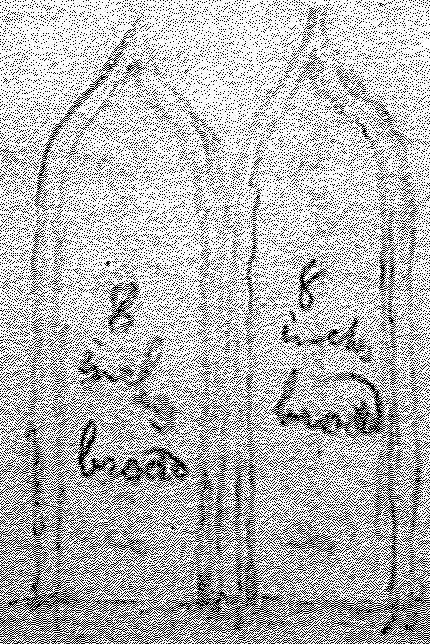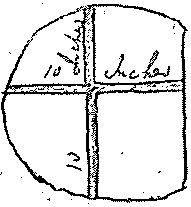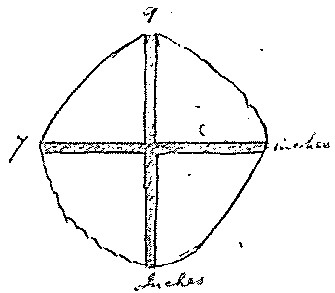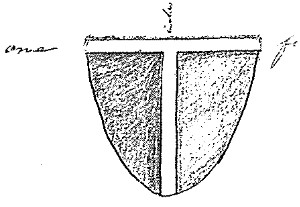Clonrush Parish in (the) Barony of Leitrim in Co. Galway - remarkable objects therein described.
November 18nth 1838
Sir,
Cluain Rois is the Irish name of Clonrush parish, which is situated in the South end of the barony of Leitrim in the County of Galway, on the West side of Loughderg on the River Shannon.
In the Descriptive remarks relating to Meelick townland in this parish, {Name-book No. 1, p 33}, it is noted that the townland contains the ruins of an abbey {&} {a} grave yard. In the 1st page of Name book No. 2, Abbey is set down as a local name, and described as situated in the South end of the townland of Meelick. The words of descriptive remarks relating to it are -
The ruins of an Abbey with a graveyard on the East side, no information can be obtained respecting it - the parish seems to have taken its name from this grave yard {Clonrush}.
In page 9, of the same Name-book, Clonrush, which is there
described as a burying place containing two vaults, (& the ruin of) an abbey in the west end, is placed in the South end of the townland of Meelick, close by the East side of the abbey
It is difficult to ascertain from these descriptions whether it was from the ruins in Meelick, the parish got its name or not. The same difficulty presents itself, when a person is consulting the inhabitants, who, when they are questioned about the old church of Clonrush, or the abbey of Meelick, point out the ruins just mentioned for both, and say that the old church in Meelick townland, bore ({or} bears) the name of Clonrush, after which the parish was called. They also say that there is a village called Clonrush in the parish, but that there was never an old church in it.
Clonrush is set down in the Name-books only as the name of the parish and as the name of the burying place just mentioned.
The Church, however, in Meelick townland, is on the inside 49 feet long and 18 feet broad. The East gable is covered with ivy, and has a window on it, of the pointed style, whose height from the ground on the inside cannot be well ascertained by reason of a heap of stones piled up against the gable. On the outside it is 2 feet 4 inches from the ground, and 2½ feet high. Its breadth is 20 inches.

On the South sidewall within 5 feet of the East gable, there is a window 2½ feet from the ground, 2 feet 9 inches broad in the lower part, and 2 feet 10 inches high. It appears to have been originally 3 feet high, having at present ivy matted in the upper part, which Conceals its real height. The form on the inside is quadrangular and a flag stone crosses the top. On the outside it is 4 feet 4 inches from the ground and about 3 feet 8 inches high, as accurately as can now be ascertained; the upper part being covered with matted ivy, which conceals its form as well as its height. The door was it appears on the west gable where there is now a large breach. Two portions of the gable remain, one attached to the South side wall and the other to the North one.
Even the breadth of the door is not now ascertainable. The western part of this Church is a construction of large stones for the most part Chiseled, some of which are very rudely (roughly) done. The South side wall is in the exterior falling fast to destruction; the stones were taken out of it, near the East gable, it appears for some purpose; and the interior is left exposed to the storms.
The whole of the western part of this Church is in materials and construction very like the old church in the parish of Letter {Lughna (Loona)} in the King's County. There is a circular archway of chiseled stones, which is 5 feet 4 inches broad at the ground, and 7 feet high, attached to the
S. West Corner of this Church, and looking to the West.
To the East of this Church, stand the ruins of a small edifice, which is called Tigh na m--Brathar ([In pencil:] Tinambraher) - (i.e.) the house of the Friars - and is on the inside 25 feet long, and 13 feet 4 inches broad. The North wall is nearly demolished; the N. West Corner remains, together with two portions of South side-wall, and a portion of East gable next North sidewall. The door was, it appears on the South sidewall, where there is now a breach separating the two portions just (now) said to remain.
A small edifice said by some to be a sacristy, and by others, a hermit's dwelling, stands to N. East of the last mentioned ruins. It is 7 feet 4 inches long inside, and 4½ feet broad, and 6 feet 3 inches high, being roofed with
stone-work, in the usual form, and plastered {inside}. On the East gable is a square opening 1 foot high, 9 inches broad. The door on the west gable is 22 inches broad and 4 feet 3 inches high; is made of chiseled stones, and pointed.
Tradition says that St. Colman kneeling on a stone placed on the ground under the opening on the East end, and looking Eastward used to hear mass celebrated at Rome. The impression of his knees was visible, it is said, is visible in the stone. From this circumstance, the little edifice is called Poll Cholomháin {pronounced Clumháin}, i.e. the cell of St. Colman.
To the South of the Church and immediately on the margin of Loughderg, the site of a castle is pointed out amidst (some) white thorn
bushes on a spot which becomes insulated generally in rainy weather, and is always surrounded with water in winter. A small part of the foundation is traceable, which exhibits a construction of stones and mortar made of lime and the sand of the immediately adjoining shore.
We find in the Inquisition of A.D. 1608 taken at Galway, that Ballynroane {1 q.} Cloynrush {1 q.} were in the possession of Ulick (Bourke) {3d Earl of Clanrickard}.
Ballynroane - is Baile an Ruain, Anglicised Ballinrooaun, a townland in the South end of the parish of Clonrush.
There is a burying place for Children in Kilcooney townland - Cill Chuanna - in this parish. Cill Chuanna signifies the Church of S. Cuanna. This is the same person, it is very probable, after whom, Cill Chuanna, now the name of Kilcoony parish, which lies not far from Headford in the barony of Clare, was called.
In Allston a subdivision of Laughil - Leath Choill - townland, is a burying place called Cill {Kill}. A holy well called Tobar na Naemh (Tobernaneeve), the well of the Saints, lies near ¼ mile from Whitegate village (&) in Laughil townland, according to local information.
The ruins of Manus' Castle {Caislean Mhaghnuis} are visible in the South East end of the townland of Drummaan West, {Druim Meadhon, (i.e.) middle drum}.
In the North East end of the townland of Illáánmor {Oilean Mór} in Loughderg, 2 miles North East of Williamstown Quay, there was, it is said, formerly an abbey occupied by Friars of the Franciscan order. The foundation of an edifice, which was probably a church, is still traceable here. The extent inside the vestiges is 34 feet by 20 ft. The door was, it appears, on the South side wall near the West gable, but the breadth of it, is not now ascertainable. About 2½ feet in height, and 4 feet in length of the South side wall between the place of the door, and the West gable, still remain.
Three feet in height of the whole extent of the North side wall, which was 41 feet long, are still visible on the outside, This is a construction of large rude stones, the spaces between which occasioned in some places by the irregularity of their form, are filled up with small rude stones and cement which is composed of lime and sand taken from the adjacent shore. At the East end, inside the vestiges of the gable, are seen three small stones, on two of which, crosses are cut; and on the third, there is one raised.



There were several small stones of nearly a round form, with crosses cut on them found at various times on the island. There was one found about 25 or 30 years ago by a man of the name of Calnan, which had an illegible {Irish?} inscription on it. He gave it to a Priest; there is nothing known about it since. The foundation of the walls that enclosed the cemetery belonging to the establishment, still marks it out
to the South of the site of the edifice just mentioned.
Between the houses of Patrick Hickey and Patrick Meara, on the island, close to the shore, where boats set out for Williamstown Quay, there is seen standing a rude stone, 8 or 9 feet high, which tradition says, was set up by the Saints who founded the Churches on Inishcaltra, to commemorate their departure from Illáánmore to the last mentioned island.
They were first beginning to build the Seven Churches on this big island; but relinquished their design
by reason of a witch, who was called Cailleach na Sioghbhruigheacht - i.e. the fairy hag - having at the very moment they were commencing the work, directed her unlucky eyes towards them.
It is said that a road led through the lake from this island to Inishcaltra. Persons can walk out a considerable distance on it, into the lake in Summer time without any danger. It appears to be a Causeway constructed with stones of great size and weight, either by the hands of nature, or by art?
In a Tract on Hymany, preserved in the Book of Leacan Folio 92. a., it is stated that O'H-uaran of Clonrush was butler to the Prince of that territory.
Roinn an airdrigh can uireasbhaidh ag Ua Uarain Chluana russ.
{literally}
O'Huaran of Clonrush, had, without limitation, the distribution {of the food} of the Prince. {of Hy-Many}
Inishcaltra will form the subject of the next Letter. I expect to finish my part of Galway in a very short time.
I always describe parishes in the order in which I traverse them, which is the reason why Inishcaltra did not come in for description till now.
